Hello, and welcome to the unoriginal world of naming different growing containers with frustratingly similar names.
Today we’re talking terrariums and vivariums (plus paludariums, aquariums, and more). They’re all closely related in name and in nature, so you’d be forgiven for mistaking one for another.
In fact, people do it all the time.
These naming conventions are supposed to make it clear what’s going inside them. The problem is the lines have gotten a little blurred.
You might think, “Who cares if I call it a terrarium or vivarium?”
Well, they’re fundamentally different in many ways – read on to find out why those differences matter.
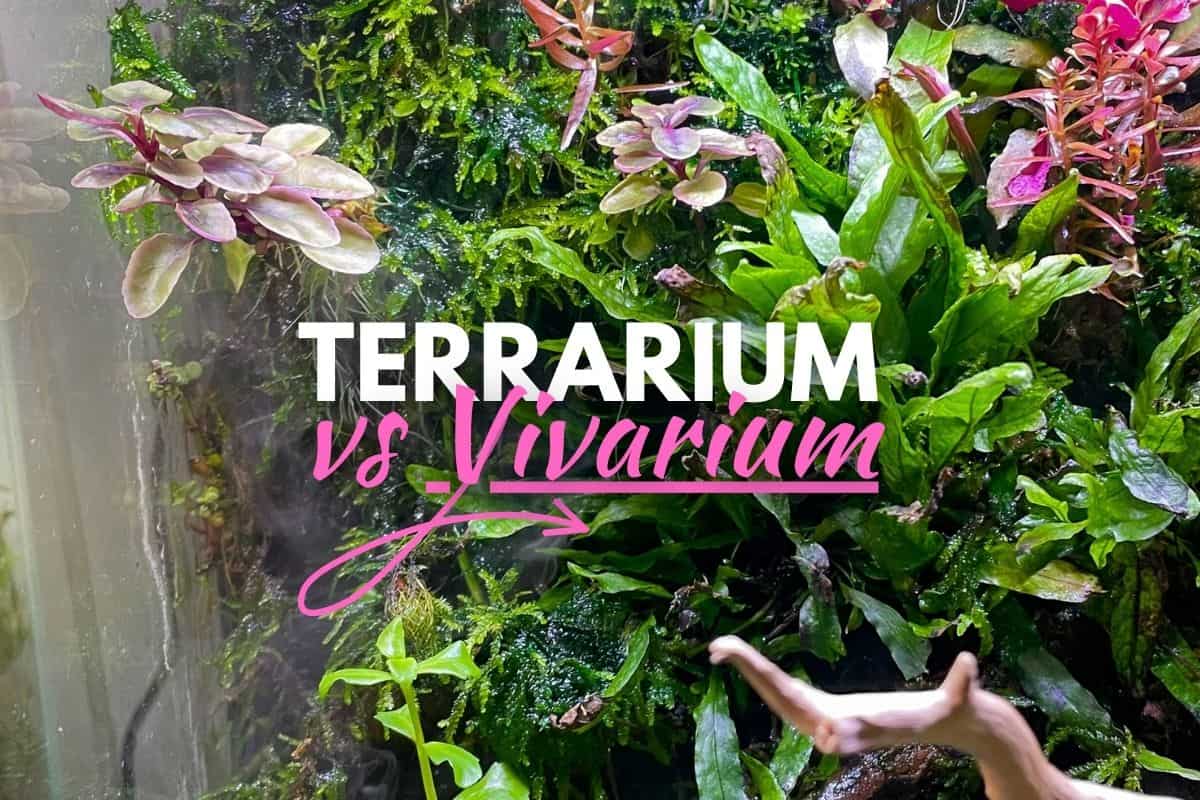
Terrarium Tribe is reader-supported. When you purchase through links on our site, we may earn an affiliate commission (at no further cost to you). 💜
Ariums: Similar Names, Different Purposes
Terrariums and vivariums often need different containers, materials, plants, and care techniques. Following a shopping list or tutorial for the wrong one can set you down a path to failure.
Terrarium and vivarium both use the Latin suffix arium, meaning “container.” But the different prefixes tell us what they’re designed to contain; terra means “earth,” and vivere means “to live.”
So, what is the difference between a terrarium and a vivarium? Though both environments can look very similar in terms of plants and earth, terrariums are designed to raise plants, and vivariums are designed primarily to be a habitat for animals.
Let’s dive in deeper.
5 Key Differences Between Terrariums and Vivariums
#1: Terrariums replicate natural environmental processes, whereas vivariums employ artificial aspects.
Terrariums are generally a plant environment sealed in a glass container to look after themselves (see my “What is a Terrarium” article for the specifics). Whereas vivariums often use pumps, filters, and external light sources to create the right conditions for animals.
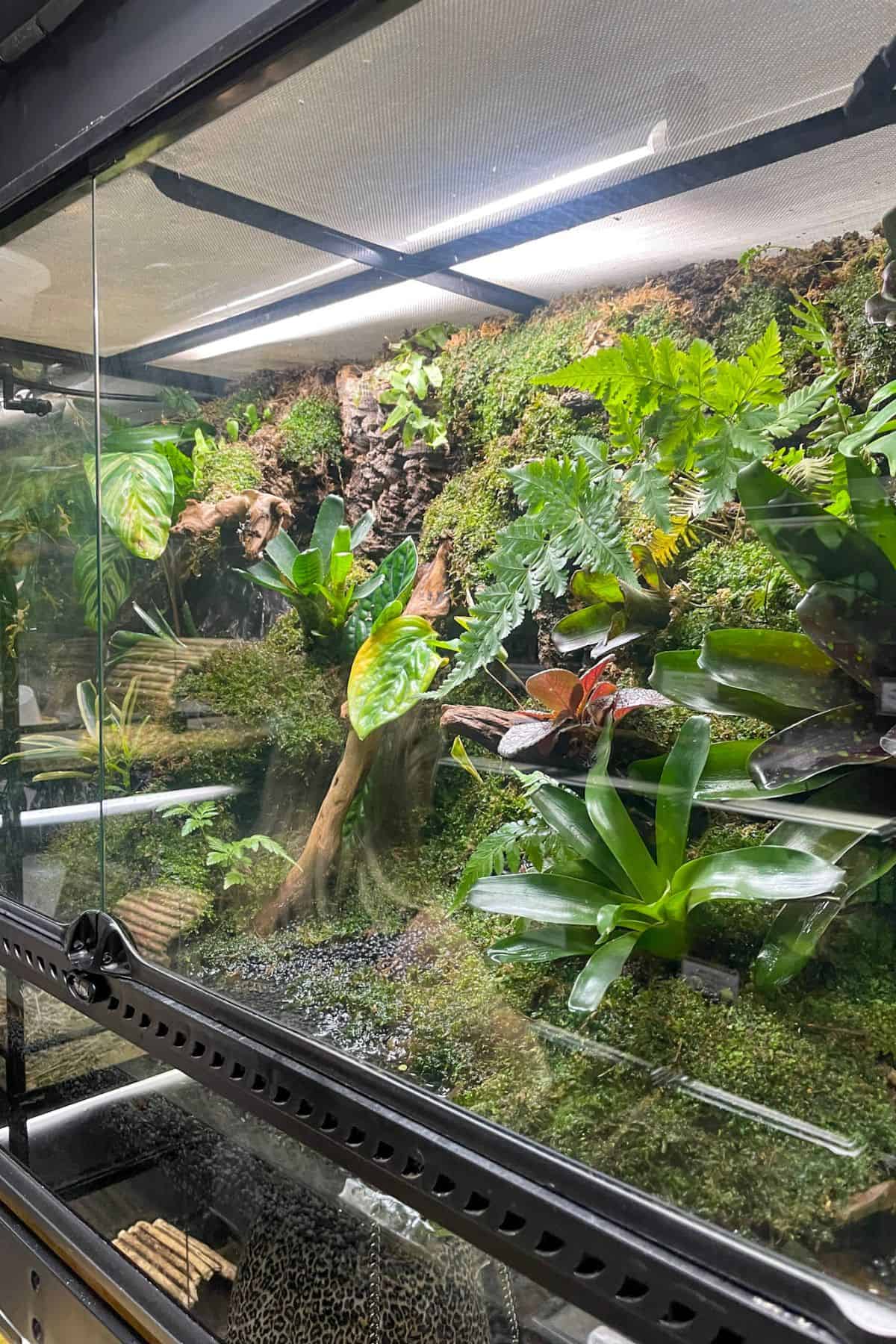
#2: They are constructed differently.
All the extra artificial components of a vivarium necessitate a different construction (good luck fitting a ventilation fan in a bottle), so if you follow the wrong advice on a build, you’re going to end up with a strangely built terrarium for your plants.
#3: They require different conditions for their inhabitants to thrive.
Humidity, watering frequency, and light levels will all be different in a container for lizards compared to a tropical plant or moss terrarium.
#4: Vivarium plants are not necessarily good terrarium plants.
The better ventilation that vivariums provide allows for the growth of particular species that require it (Bromeliads probably being the main type here). Whereas these plants may struggle in a sealed container designed for tropical closed terrarium plants.
#5: Vivariums are planted differently.
You’ll often see vivarium plants grouped into categories like “foreground plants,” “carpeting plants,” and such. In theory, you can take this approach with a bigger terrarium, but it’s not typically the same process.
The Problem With the Term “Vivarium”
The term vivarium is the anomaly here.
As you’ll see later in the article, there are lots of different “ariums,” and each describes a different environment. Terrarium means land, and aquarium means water, for example.
Then we have vivarium, which roughly translates to “place of life.”
But life isn’t an environment; it’s a feature – and an ambiguous one at that.
Plants are living, after all; does that make a terrarium a type of vivarium? Then again, a typical vivarium does contain earth elements and could feasibly be a terrarium with animals…
So, is a vivarium a type of terrarium, or vice-versa?
You could go around in circles forever with this reasoning. To me, the naming comes down to practicality, not pedantic classification.
It’s the priority behind the system that matters.
The priority of a terrarium is to create an environment where your plants thrive. Whereas the pets are the priority in vivariums, and the plants play a secondary role in making the animals comfortable and happy.
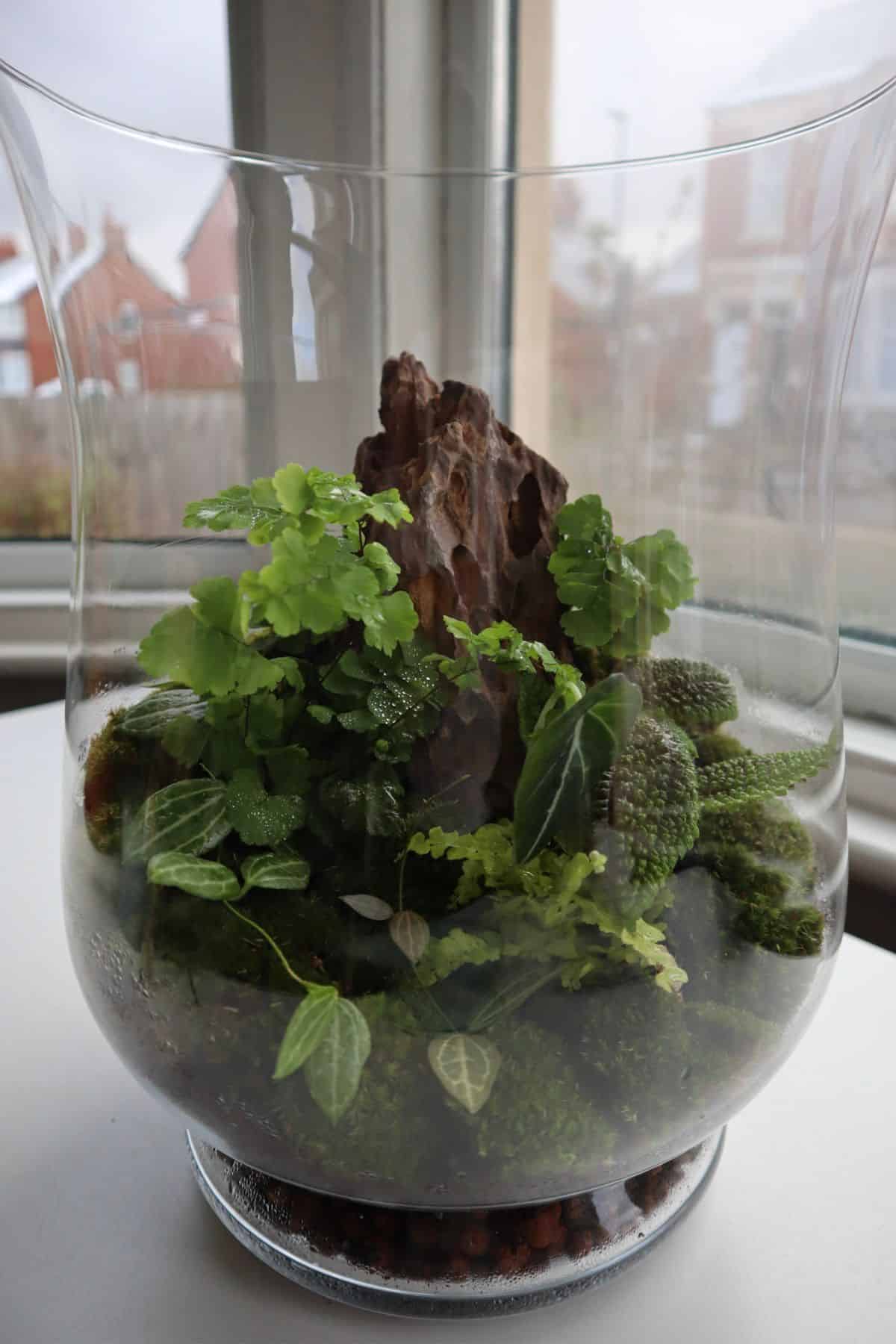
Look, this isn’t a super strict rule; I’m not going to crack down on everyone with an undocumented isopod in their terrarium.
But, it is important that you optimize your system for what you want to grow.
Learn Your “Ariums”
The naming madness process doesn’t stop with terrariums and vivariums. A host of other containers/environments follow the same pattern.
- Mossarium – A mossarium is a container dedicated entirely to growing moss. It might sound a little dull, but you’d be surprised how beautiful these can be. I am partial to a bit of moss.
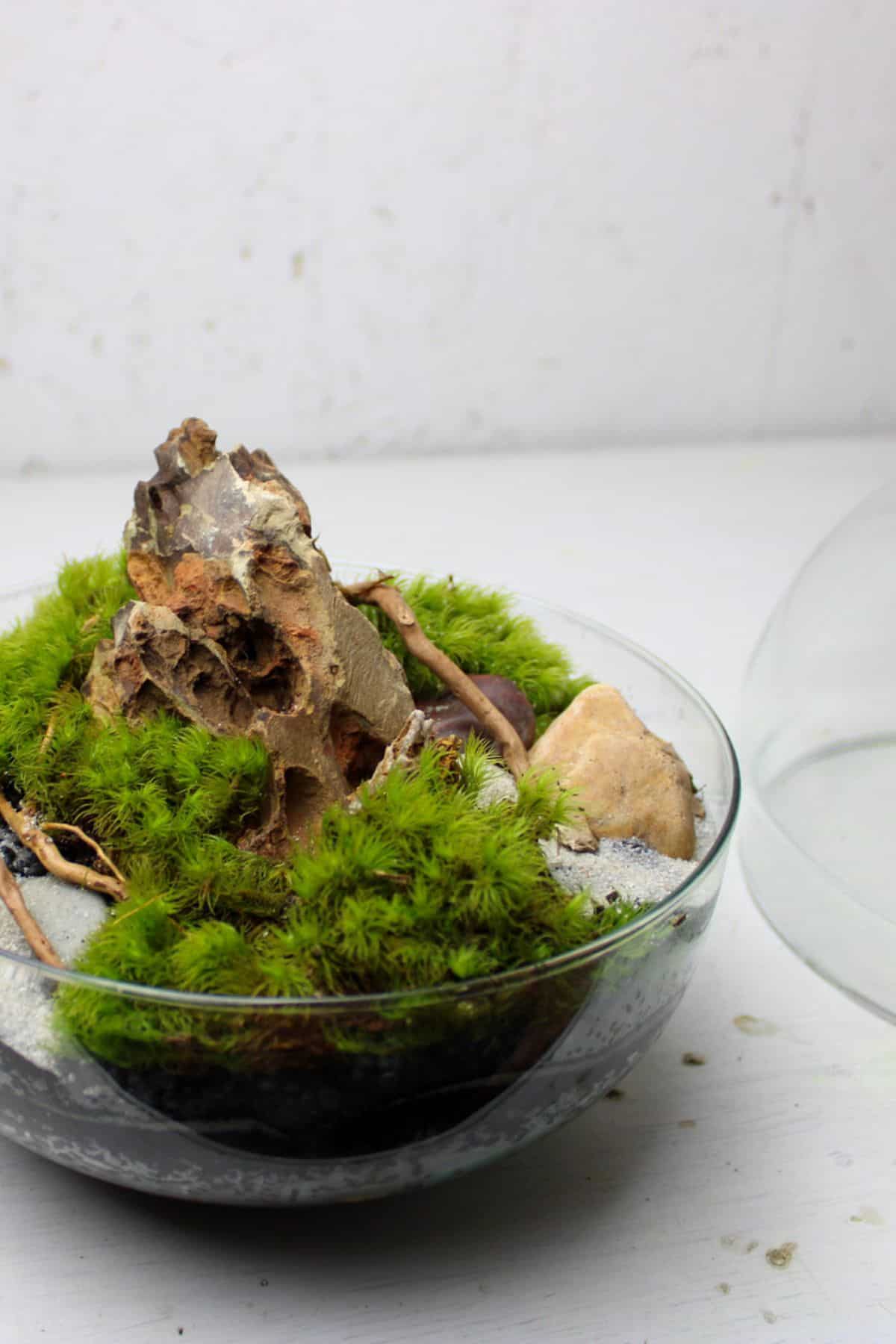
- Aquariums – Come on, we all know what an aquarium is. Coming from the Latin “aqua,” meaning water, these environments are fully aquatic and can be used with saltwater or freshwater to raise all manner of fish and crustaceans.
- Oceanarium – This one you might not have heard of. It’s basically a large aquarium. Interestingly, I get most of my terrarium design tips straight from the aquascaping world.
- Paludarium – Paludariums contain both earth and aquatic elements. Which is fitting for a word that comes from the Latin word “palus,” meaning swamp. They’re never really swamps, though. Rather an even split between an aquarium and a vivarium favored for raising semi-aquatic animals like lizards and frogs. So, they’ll often contain basking rocks, some sort of waterfall, and some undergrowth for amphibians to hide.
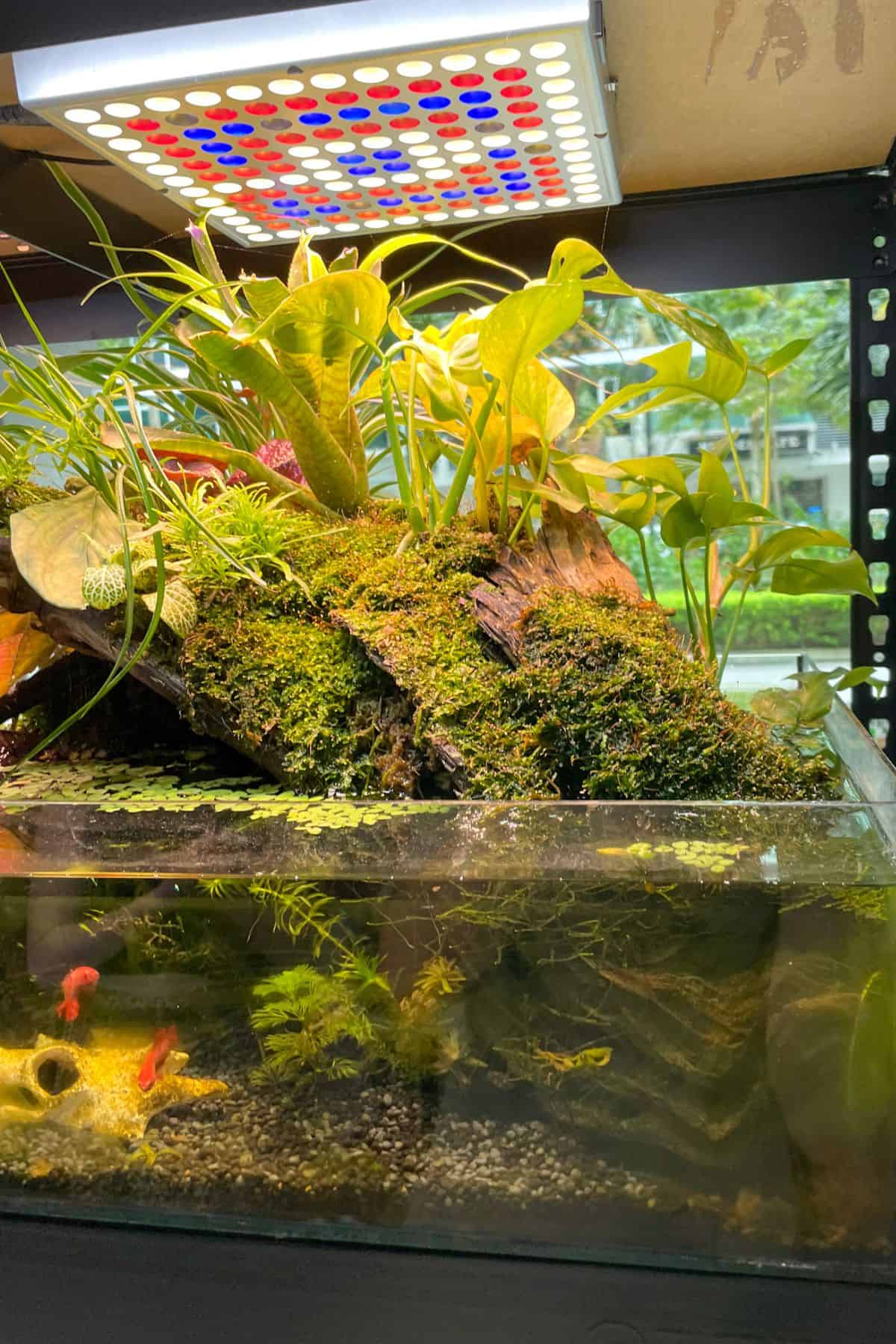
- Riparium – Ripariums are similar to paludariums in that they contain earth and aquatic elements. But rather than an even split, in a riparium, the land takes a complementary role in creating a shoreline. The purpose of a riparium is to create an environment like a riverbank. After all, the word comes from the Latin “ripa,” meaning river.
Then you also have ariums that follow the animal pattern.
- Insectarium – A habitat built to raise all manner of insects, from beetles to worms (though there are some terrarium/vivarium insects we recommend everyone adds).
- Formicarium – Otherwise known as an ant farm.
- Penguinarium – The rocky environments you see in zoos with a big pool in the front.
- Dolphinarium – You get the idea.
In the End, Does it Matter?
As long as you’re aware of the differences, then no.
Call your collection of mosses a penguinarium if you like; I just wouldn’t recommend following care advice for one. “Feed two fishes per day, every day.”
It doesn’t upset me that the terms are used incorrectly, but I hate seeing people waste time and money on irrelevant things.
Hopefully, this article has helped in some way to steer people in the right direction.

Omg.. literally the best laugh-out-loud plant article I have ever read. Thank you.
Indeed. someone has had too much time and therefore has come up with a few different names for one and the same thing. LOL
Thanks a lot for the article, this is very useful and informing.
Haha thanks for the information. I just finished working on a vivarium but after reading this article i was like “oh so this is a terrarium then” HAHAHA
Just trying to save the world, one terrarium at a time 😉
Thanks for this – my snake is in a vivarium but when someone asked me the other day what the difference was to a terrarium I’d couldn’t actually say – every days a school day 🙂
yeah I do ready about both terrarium and vivarium. these terms are real little bit confusing me from the begging , but as i go through reading there meaningful I learned that they are different at some point. Now my question is that , is there any difference between vivarium and ecosystem?
The word vivarium mostly refers to the container itself, but to be fair, in context it does tend to mean the ecosystem within too.
Thank you for expanding my imaginarium.
lol this was a cute comment
This was SO helpful, I had no idea paludariums were a thing, but I’ve been researching pet snails, and happened to come into possession of a ~50 gallon vertical tank. Much bigger than I needed for my snails, so I wondered about having a aquarium+terrarium combo, for snails and a betta (which I’ve owned before). This gave me all the terminology i need to figure out if its feasible for me!
In the end, Mortuarium.
Totally into terrariums now. I was unsure of the kind of people in this crowd, but I’ve never laughed and learned so much in so little time.
Wait.. does that mean we’re all on a Humanarium?
😂 Food for thought!
In the world of reptiles, we do the opposite for vivariums and terrariums. A terrarium is an artificial environment for reptiles, usually desert dwellers and reptiles or other critters that would want a more sandy or rocky environment. Like you said Terra for earth right? Basically just a dirt/sand/woodchip substrate.
A vivarium on the other hand would have a more natural soil substrate with living plants and insects to mimic the natural environment of reptiles that live in more humid environments. Like you said viverre for to live.
In the pet hobby, artificial aspects are expected for both and the vivarium is the more likely of the two to be self sustaining or a closed system. Often times, especially in Canada, where I’m located, heat pads and uv lamps are usually required (depending on what you’re raising). I’ve also a fair amount of experience with a lot of the other “ariums” as well. I’ve yet to do saltwater, but I’ve had all sorts of freshwater tanks, paludariums, and ripariums as they relate to hobbyists.
This is a great article other than that bit of semantics or pedantics to be argued, but thats a given in the hobbies regardless especially when talking about multiple hobbies like herpetology vs horticulture vs fishkeeping
Thanks for your insights Josh! It just goes to show, depending on the context there’s a good justification for using the terminology in all sorts of ways. I have no strong preferences either way, I just wish they were consistent. 😂
And so at 65yrs I have read everything here and am more confused than ever! I wish I could post a photo for you to see, My open tank has half water with fish ( fan tails ), and the top half I have plants from down the woods and river bank, primarily Moses and tiny ferns, so How am I to call the tank please? ( getting old is fun )
🤣 I’d say you can choose between riparium and paludarium depending on how you feel!
Could even be a basketarium!
Lol.
Seems to me that the terms, specificly “terrarium” has different meaning in USA vs Europe! Especially if you leave internet and check printed matter – in different languages. Germany and UK started this during 1830s to 1850s. Terrarium being the general term, meaning any container with animals and plants above the water surface.
I am a Swedish retired biologist writing about different item like history of aquariums. Good luck to you two!